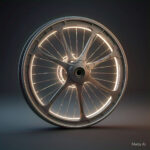Introduction
Mountain biking delivers amazing feelings though having a top engine performance needs basic bike upkeep. A regularly tended bike functions better while keeping you safe and working as it should for a long time. Getting familiar with good MTB cycle maintenance builds better value and riding quality for all riders from novices to experts.
This guide explains essential MTB cycle maintenance steps and shows beginners how to pick their ride while teaching riding basics plus selecting great MTB cycle accessories.
1. Become Familiar with the Different MTB Cycles and and Features
Before starting maintenance work you need to identify and understand various MTB types with their components. Bike riders use mountain bikes according to the suspension system, riding surfaces, and preferred movement methods.
Types of MTB Cycles
- Hardtail MTB Bikes Include Only a Front Suspension Fork Because They Lack Rear Suspension. The bikes suit new riders because they stay lightweight and need basic care.
- Full-Suspension MTB Cycles contain suspension systems both in front and back which makes handling challenging trails much easier.
- MTB Cycles with no suspension require little care while offering easy handling. Suitable for smooth trails.
Key Features to Consider
- Choose from aluminum for low weight, carbon fiber for first-class performance or steel for durability and affordable price.
- The tool used for effective braking matters as Disc brakes stop better yet weigh more than Rim brakes that slow down poorly when wet.
- Bikes use three main wheel sizes to ride called 26-inch, 27.5-inch, and 29-inch. Bicycles with bigger wheels can easily cross through challenging ground surfaces.
- Bikes have either single-speed or multi-speed gear systems that match terrain difficulty.
2. Essential MTB Cycle Maintenance Tips
Regular attention to MTB parts stops problems beforehand and lets you enjoy a perfected bike environment. The steps to maintain bike performance include:
Cleaning Your MTB Cycle
Clean your bike right after rides on slippery terrain following proper cleaning procedures.
- A delicate brush and small soap works best to clean your bike.
- Spray clean water gently without hitting the bearings and seals.
- Dry the parts with a soft cloth to protect against rust development.
- Protect metal parts with spray solution to stop corrosion from forming.
Lubricating the Chain
Your bike depends on its chain to perform well throughout your rides.
- Use bike chain oil to make movement between chain links easier and slow down chain breakage.
- Keep remnants of lubricant off the chain to block dirt entry.
- Using too much lubricant brings in more dirt and dirt particles.
- Regularly apply a degreaser to clean away the old lubricant buildup.
Checking and Adjusting Brakes
MTB safety depends on proper brake function.
- Test brake pad condition and install new ones when needed.
- Test the brake system to be sure it uses proper brake cable and fluid movement.
- Tune the braking system to stay clear of the disc running surface.
- Check brake effectiveness before each journey to verify prompt activation.
Inspecting the Tires and Wheels
Maintaining your tires controls your grip with the road which requires your attention.
- You should always inspect tire pressure before setting off on your ride for mountain biking at 25-35 PSI.
- Search the tire surface for damage and foreign objects.
- Test wheel alignment and tighten all spoke bolts to fix any wheel wobble.
- Alternate tire positions on your vehicle creates equal tire wear.
Suspension Fork and Rear Shock Maintenance
The suspension system of a car absorbs impact to protect riders and passengers by making their journey smoother.
- The suspension system works better when its seals are regularly cleaned and lubricated.
- Examine the air shock pressure level to optimize its functioning.
- An experienced technician should inspect your suspension fork once each year.
- Stay away from deep mud and water to make your suspension remain durable.
Checking Bolts and Fasteners
Damaged bolts threaten your safety while riding.
- An adjustable wrench helps you apply exactly the bolt tightening torque that product makers define.
- Verify that bolts and parts inside your stem, seat post and crankset remain tight.
- Secure riding stability with proper tightening of pedal and handlebar components.
Drivetrain Maintenance
A drivetrain that operates freely with clean lubricant helps your bicycle shift easily while ensuring maximum engine power delivery.
- Degrease all surfaces of the chain, cassette, and bail pulleys.
- Check cable ends for damage and put new ones in their place when necessary.
- Make the derailleur operate more accurately through adjustment procedures.
- Regularly check your chain wear level to replace it prior to harming other parts.
3. Choosing the Right MTB Cycle
Decide on an MTB cycle by evaluating all these features:
- Your MTB needs smooth terrain support for a hardtail but adds technical trails for full suspension and goes strong with heavy-duty suspension.
- Your riding height and preferences require a bike with proper frame dimensions.
- Different bike prices exist for entry-level bikes at $500-$1,000 and $1,000-$3,000 for mid-range bikes, plus $3,000+ for top-performance bikes.
- Purpose – Recreational, competitive racing, or endurance riding.
- Having a bicycle that weighs less makes it simpler to move but more vulnerable to damage.
4. MTB Cycle Gear and Accessories
Using suitable MTB cycle equipment makes you safer and helps you perform better.
Must-Have Accessories:
- Helmet – Protects against serious head injuries.
- Gloves create better connection to the handles and make hands feel less tired.
- Hydration Pack – Essential for long rides.
- Having bike lights protects you when riding at night and in minimal light conditions.
- A multi-tool helps you fix bike problems at any moment.
- The Puncture Repair Kit contains tools that fix flats including tire levers patches and a pump.
- Cycling shorts paired with your jersey will create better comfort and protect you from skin irritation.
Upgrades to Enhance Performance:
- Tubeless tires decrease damage by flats and maintain better contact with the road.
- You can change saddle height from the riding position when using this post setup.
- Shaft bicycle pedals enhance pedal movement efficiency.
- GPS Bike Computer – Tracks your speed, distance, and route.
- Upgrade the suspension to manage harsh ground better.
5. MTB Cycle Riding Techniques for Beginners
Proper riding skills build both your self-assurance and security.
Body Positioning
- Neutral Position – Keep knees and elbows slightly bent for better control.
- when facing technical terrain stand on your pedals keeping your knees and elbows bent.
Braking Techniques
- Normal brake pressure should be applied to all wheels together to control both wheels smoothly.
- Slowly apply both brakes as you go down steep mountain bike paths.
- You should slow down in a gradual manner when riding over loose surface areas to avoid slipping accidents.
Shifting Gears Efficiently
- Begin changing gears before starting an uphill section instead of during it.
- Steer clear of crossing chainrings since it strains the bike’s power section.
- Change to higher gears when riding on open fields but switch to lower gears when going uphill.
Cornering Tips
- Keep the bicycle frame tilted instead of leaning with your body while making turns.
- Position your body weight straight down the middle as you watch the road ahead.
- Drive the bike at a constant rate to stay safe.
Climbing & Descending
- Downshift to lower gears when heading up a slope but stay centered over the frame.
- Use your body weight to move down from the pedals while keeping your heels pressed to the ground.
- Relax your body to better absorb bumps during off-roading rides.
Conclusion
Keeping your MTB cycle ready improves both its performance and prevents accidents while extending its service life. Regular bike checks with oil applications stop breakage problems while giving you better riding comfort. Your mountain biking experiences will improve when you learn to use correct equipment and develop basic bicycle controls.
By using these recommended care methods and right riding methods you will keep your bike functional so you can enjoy better rides.





